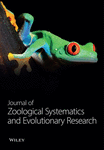Age-Stage, Two-Sex Life Table of an Alarming Quarantine Pest Trogoderma granarium on Stored Products
Abstract
Trogoderma granarium (Coleoptera: Dermestidae) is a polyphagous pest of stored products and an alarming threat to food security around the globe. The current study is designed to construct the life table of T. granarium on four stored products, i.e., wheat, barley, rice, and maize at controlled conditions (33 ± 1°C, 65% RH, and a photoperiod of 14 : 10 (L:D) h). The incubation period of T. granarium was longer (5.13 d) on maize and shorter (4.30 d) on wheat. The developmental period of 1st, 2nd, 3rd, and 4th larval instars of T. granarium was longer on maize than the other three hosts were significant. Statistical difference between the longevity of females and males was recorded, while no statistically significant difference was found in the preoviposition period. The mean fecundity values observed on wheat, barley, rice, and maize were 31.33 ± 1.62, 26.21 ± 1.49, 28.00 ± 1.35, and 25.58 ± 1.13, respectively. The highest fertility was observed in wheat and the lowest in maize. The net reproductive rate (R0) of T. granarium ranged from 8.66 ± 2.86, 13.16 ± 2.65, 12.53 ± 2.27, and 10.23 ± 2.32 offsprings on wheat, barley, rice, and maize, respectively. The highest gross reproductive value (GRR) was for T. granarium reared on barley (18.31 ± 4.10/d), and the lowest was for maize (15.35 ± 2.95/d). To complete the development, T. granarium took 48.97 ± 0.68 d on maize, significantly higher than on other treatments (p < 0.05). The mean generation time (T) of T. granarium was considerably affected by tested products. Based on the results of the present study, maize is a less favorable diet for the development and reproduction of T. granarium and may be considered for the management of this detrimental pest.
1. Introduction
Cereals are stored in traditional storage containers after harvesting for long durations for long-term use and to keep them safe from spoilage. Spoilage of stored grains is due to inadequate and inefficient storage facilities, possibly due to problems arising from different biotic and abiotic factors. Storage insect pests constitute a severe threat among the biotic factors that affect the stored cereal grains and destroy their quantity and quality. Trogoderma granarium is a significant pest of several stored products like dry fruits and oilseeds, but cereals crops such as wheat, rice, maize, and barley are considered the preferable foods of T. granarium in tropical and subtropical regions of the globe [1, 2].
Larvae are in the destructive stage of T. granarium, consume seed embryos, and reduce the quality (nutritional value) and quantity (weight) of grains with economically huge losses [3–7]. The larvae significantly reduce seeds’ commercial value and emergence rate, ultimately affecting crop production. Approximately 9-20% of postharvest losses are caused by severe pest attacks under favorable environmental conditions [8, 9]. Larvae are voracious primary feeders, survive in low moisture contents, and live up to 3 years. This noxious or dreaded pest has been reported as a quarantine pest and a major alarming threat to global food security [10–12] by the European and Mediterranean Plant Protection Organization (EPPO) [11, 13].
The presence of this pest causes harm to stored grains through excretion, exuviations, corpses, and their existence within the products, which is not ideal from a commercial standpoint. Insecticides (deltamethrin, permethrin, indoxacarb, and spinosad) [1, 14, 15] and fumigants (aluminum phosphide, methyl bromide, and sulphonyl fluoride) are the extensively used practices to control T. granarium [16, 17]. The use of insecticides can manage the pest population, but excessive applications not only cause pest resistance and harmful effects on human beings and animals [18–20] but also products unconsumable by the human community that cause severe losses [21, 22]. Diapause is the strategic characteristic of the T. granarium life cycle; larvae in diapause are tolerant to insecticides, contributing to its longevity and invasive success. The challenges involved in controlling the T. granarium are reinforced by the fact that chemical applications for pest control are problematic as mentioned above.
An effective and alternative control measure is required to protect the ecosystem and avoid the harmful effects of insecticides on humans and foods. However, proper life history knowledge of the target pest is necessary before developing any method or tool. The developmental period of each stage of insect pests is varied with respect to diets/hosts. However, some life histories of T. granarium on stored products have been documented by entomologists. For example, Golizadeh and Abedi [23] have studied the life parameters of T. granarium on wheat cultivars but the comparative life table of pest on different products by using the age-stage, two-sex life table is missing which needs to be studied. Age-stage, two-sex life table is the best way to determine insect pests’ biological parameters [24]. By filling this research gap and providing proper guidance related to pest parameters, we can figure out whether host plants/products affect the biological parameters of the pest. The results of this table will permit the further development of area-wide integrated pest management strategies against T. granarium on tested stored products.
2. Materials and Methods
2.1. Insect Culture and Grain Source
Larvae of T. granarium were collected from different areas of Multan and Muzaffargarh, Punjab, Pakistan. The collected larvae were brought to the laboratory and reared on wheat (Triticum aestivum) as a suitable host [1] for two generations under controlled conditions (33 ± 1°C, 65% RH, and a photoperiod of 14 : 10 (L:D) h).
2.2. Life History
Newly laid eggs were picked with a fine paintbrush from the colony and placed individually in each Petri dish (diameter 6 cm, depth 1 cm), containing one seed of each host/treatment [1], and each petri dish was considered a replication. There were four treatments/hosts, each with thirty replications. Petri dishes were checked daily, and the biological and morphological traits (egg-adult) were recorded visually and using the stereomicroscope. After exclusion, newly emerged male and female adults from each host were separated based on their genital lobe morphology and transferred to the plastic tubes (one male and one female) containing the seeds of each host. The number of adults coupled for each cultivar depended on survival from the previous stage and ranged from 15 to 26 pairs. Daily adults were transferred to the new tubes with food provided. The fecundity of each female fed each host was counted daily using a stereomicroscope, and eggs were maintained for 30 days to determine their hatching percentage (fertility). The procedure of [25] was followed to check the pest’s whole life history parameters (egg-adult) in the current study. The biological and morphological traits of pests were determined by the age-stage, two-sex life table analysis [25].
2.3. Statistical Analysis (Age-Stage, Two-Sex Life Table)
- (i)
Age-Stage-Specific Survival Rate ( Sxj ). x is age, and j is the stage
- (ii)
Age-Specific Survival Rate ( lx ). x is age
- (iii)
Age-Specific Fecundity ( mx ). The number of eggs per female at age x
- (iv)
Age-Stage-Specific Life Expectancy ( exj ). The time duration in which an individual of age x and stage y is expected to live
- (v)
Age-Specific Maternity ( ). The combination/product of lx and mx
- (vi)
Age-Stage-Specific Fecundity ( fxj ). The number of hatched eggs a female adult lays at age x
- (vii)
Age-Stage-Specific Reproductive Value ( Vxj ). The contribution of individuals of age x and stage y to the future population:
- (i)
Intrinsic rate of increase (r):
- (ii)
Finite rate of increase (λ):
- (iii)
Net reproductive rate (R0):
- (iv)
Mean generation time (T):
- (v)
Adult preoviposition period (APOP) and total preoviposition period (TPOP) were also calculated by using the method in [29].
3. Results
The incubation period of T. granarium was longer (5.13 d) on maize while shorter (4.30 d) on wheat. The developmental period of the first, second, third, and fourth instars of T. granarium was longer on maize than the other three hosts (p < 0.001). A significant difference was found between each stage of the pest on different hosts. Males and females of T. granarium were long lived on rice and barley with significant differences to wheat and barley (p < 0.001). Statistical difference between the longevity of females and males was recorded, while no statistically significant difference was found in the preoviposition period. Statistically, the pest’s fecundity, TPRP, and oviposition period were significantly different in each host. TPOP/TPRP was higher on maize followed by rice, barley, and wheat. The shortest and longest oviposition periods were recorded on maize and wheat. The mean fecundity values on wheat, barley, rice, and maize were 31.33, 26.21, 28.00, and 25.58 eggs, respectively (Table 1). The intrinsic rate of increase (r) was significantly higher for wheat and barley in comparison to rice and maize (p < 0.05). The GRR and R0 were significantly higher on wheat and lower on maize (p < 0.05). T. granarium took 48.97 ± 0.68 days on maize to complete the development which was significantly higher than on other treatments (p < 0.05) as given in Table 2. A significant difference was found between morphological traits of T. granarium on different hosts as given in Table 3.
| Traits | Diets | |||
|---|---|---|---|---|
| Wheat | Barley | Rice | Maize | |
| Egg (d) | 4.30 ± 0.25b | 4.66 ± 0.21a | 4.43 ± 0.26b | 5.13 ± 0.23a |
| First instar (d) | 4.91 ± 0.21a | 5.26 ± 0.27a | 5.32 ± 0.21b | 5.03 ± 0.21b |
| Second instar (d) | 5.47 ± 0.20b | 6.03 ± 0.23a | 5.80 ± 0.21b | 6.00 ± 0.21a |
| Third instar (d) | 5.26 ± 0.22b | 6.26 ± 0.22a | 6.20 ± 0.22b | 6.29 ± 0.11a |
| Fourth instar (d) | 6.16 ± 0.19b | 6.15 ± 0.16b | 6.52 ± 0.20a | 6.45 ± 0.10a |
| Fifth instar (d) | 6.28 ± 0.22b | 6.42 ± 0.19b | 6.34 ± 0.21b | 7.08 ± 0.16a |
| Pupa (d) | 5.00 ± 0.26a | 6.07 ± 0.20a | 6.00 ± 0.16b | 5.83 ± 7.63b |
| Male (d) | 53.92 ± 1.43a | 54.08 ± 1.36a | 48.53 ± 0.95b | 53.40 ± 0.88b |
| Female (d) | 56.33 ± 0.76a | 54.14 ± 0.98b | 54.20 ± 1.28b | 55.66 ± 0.86b |
| APOP/APRP (d) | 1.00 ± 0.00b | 1.00 ± 0.00b | 1.00 ± 0.00a | 1.00 ± 0.00a |
| TPOP/TPRP (d) | 42.33 ± 0.76b | 43.28 ± 0.91a | 41.30 ± 1.10b | 44.68 ± 0.58a |
| Oviposition (d) | 11.83 ± 0.66a | 10.35 ± 0.40b | 10.70 ± 0.29a | 10.08 ± 0.30b |
| Fecundity (d) | 31.33 ± 1.62a | 26.21 ± 1.49a | 28.00 ± 1.35b | 25.58 ± 1.13b |
- APOP: adult preoviposition period of a female adult; APRP: adult prereproduction period of a female adult; TPOP: total preoviposition period of female counted from birth; TPRP: total prereproduction period of female counted from birth; d: days. Using the bootstrap test means that the same row followed by the same superscript letter is not significantly different (p > 0.05).
| Parameters | Stored products | |||
|---|---|---|---|---|
| Wheat | Barley | Rice | Maize | |
| r | 5.18 ± 5.25a | 5.01 ± 4.52a | 5.38 ± 6.18b | 4.74 ± 4.96b |
| ʎ | 1.04 ± 5.53a | 1.05 ± 4.76a | 1.05 ± 6.46b | 1.04 ± 5.19b |
| GRR | 20.40 ± 3.51b | 18.31 ± 4.10a | 17.34 ± 3.78a | 15.35 ± 2.95b |
| R0 | 8.66 ± 2.86a | 13.16 ± 2.65a | 12.53 ± 2.27b | 10.23 ± 2.32b |
| T | 46.04 ± 0.66b | 47.73 ± 0.91a | 46.95 ± 1.22b | 48.97 ± 0.68a |
- r: the intrinsic rate of increase (per day). ʎ: the finite rate of increase (per day). GRR: gross reproductive rate (offspring). R0: the net reproductive rate (offspring/individual). T: the mean generation time (day). Those that do not share a superscript letter are statistically significant.
| Stored products | Larvae weight (g) | Pupa weight (g) | Male weight (g) | Female weight (g) |
|---|---|---|---|---|
| Wheat | 6.45 ± 0.04a | 3.09 ± 0.01a | 4.12 ± 0.01a | 4.30 ± 0.00a |
| Rice | 5.78 ± 0.03b | 2.99 ± 0.00ab | 3.85 ± 0.02a | 3.89 ± 0.01a |
| Maize | 5.19 ± 0.06c | 2.95 ± 0.04b | 3.77 ± 0.04b | 3.96 ± 0.03b |
| Barley | 5.85 ± 0.09b | 3.05 ± 0.01ab | 4.05 ± 0.04b | 4.29 ± 0.06b |
| ∗LSD (p < 0.05) | 0.35 | 0.13 | 0.18 | 0.19 |
- Those that do not share a superscript letter are statistically significant.
The age-stage-specific survival rate (Sxj) of T. granarium feed on different hosts is shown in Figure 1. The significant differences in larvae survival rates were recorded on hosts with higher rates of wheat and barley. The age-specific reproductive value (Vxj) significantly differed on tested hosts (p < 0.05). The highest Vxj was recorded at wheat host compared to other tested hosts as shown in Figure 2. The inverse relationship was found between the hosts and age-specific survival rates, while a direct relation was recorded between hosts and age-specific fecundity, as shown in Figure 3. Age-specific maternity was also directly proportional to hosts. Age-stage-specific life expectancy (exj) of T. granarium at each stage was affected by hosts. exj was recorded as highest on wheat and lowest on maize. The reproductive potential of the pest was increased after adult emergence from pupae and then decreased on each host. The influence of hosts on survival rate and fecundity is shown in Figure 4. lx on all tested hosts showed a downward trend with increasing age. The death of the last instar on wheat, barley, and maize occurred at 61 days, while at 65 days at rice. fx, mx, and reached maximum values at 35, 38, 40, and 39 days on wheat, barley, maize, and rice, respectively. mx and were recorded highest at wheat followed by barley, maize, and rice. The highest fecundity and hatching percentage were recorded for females from larvae reared on wheat followed by barley, and rice, while lowest on maize as given in Figure 5.
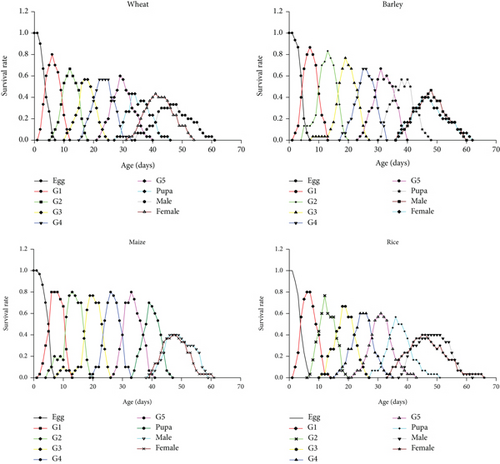
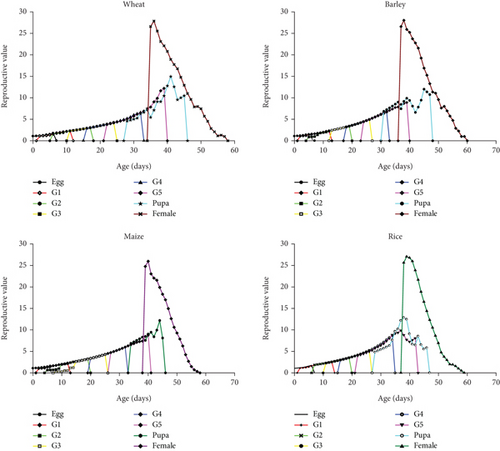
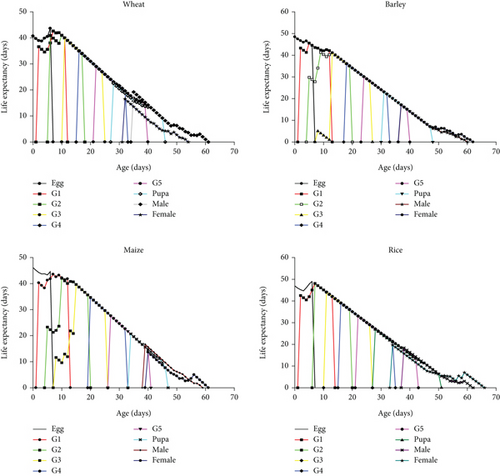
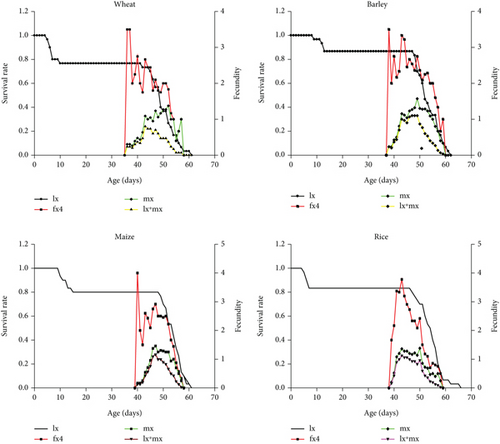
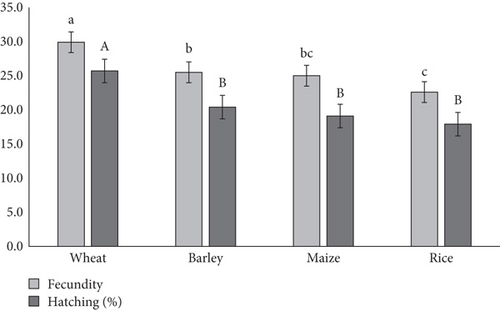
4. Discussion
Trogoderma granarium is a highly destructive pest of stored products and one of the major quarantine threats to food security and international trade worldwide. Highly significant damage can occur in storage, food processing facilities, and homes [11]. The products become unfit for human and animal consumption and even unmarketable due to contamination. Its ability to infest a wide range of commodities and its resistance to control measures make it a challenging pest to manage. The present study was carried out to determine the life table of this pest using an age-stage, two-sex life table that leads to proper management tactics. The construction of a life table can help predict potential outbreaks of T. granarium on different products. Understanding the biological and morphological parameters of T. granarium on different hosts allows researchers and policymakers to develop effective pest management strategies to mitigate infestations on more susceptible commodities.
Several authors have studied that diets influence the life history such as development, reproductive values, survival rates, and fecundity of stored-product pests including T. granarium [30–33]. Many authors have previously reported the resistance of this T. granarium on several cereals [1, 23, 33, 34]. The current study aimed to determine the fitness parameters of T. granarium on different hosts using the age-stage, two-sex life table. The results indicate that hosts significantly affect the life history of T. granarium and pests can complete its growth on hosts at different rates. The number of instars and developmental time of each stage could be affected by the composition of the nutrients in the hosts. The current study findings align with the previous studies [35]. The number of instars varies from 1 to 10 depending on the larvae food. In the current study, five instars were found on all the tested hosts, while [30] reported six on barley and seven on wheat [23]. In our study, the overlapping in curves of Sxj shows the potential of the age-stage, two-sex life table in displaying the stage dissociation of T. granarium due to variable developmental rate between individuals. Similarly, stage differentiation can be perceived in curves of exj [36].
The developmental period of larvae was higher on barley than wheat, while [30] reported a higher period on wheat than barley. The longer developmental period was on maize and the lowest was on wheat. Maize was unsuitable for the growth and development of T. granarium than all tested hosts. It shows that larvae need more nutrients or food for nourishment, which is insufficient for larvae to complete growth when fed on maize. Borzoui et al. [1] reported that barley was an unsuitable host for T. granarium, which was found best for pest growth in this study. In Iran, barley is considered a suitable and delicious food for T. granarium. This difference may be due to the presence of nutrients and the suitability of these hosts [37]. The insect body weight is highly associated with the quality and quantity of host plants, as reported by many authors [38–40]. The lowest body weight of larvae on maize showed that maize is unsuitable food due to lack of nutrients. The fecundity, fertility, and adult longevity depend on the food larvae consume in their stage [1]. The mean generation time was significantly different on each tested host, as reported by Papanikolaou et al. [41]. Among other tested hosts, the highest survival rate of T. granarium was observed on wheat followed by barley, rice, and maize.
Awadalla et al. [42] reported significant differences in the survival rates of T. granarium in wheat and maize. Maize and wheat were recorded as the most suitable hosts for pest rearing. The hosts with low protein levels preferred T. granarium [1, 33]. The concept of the “r” value was introduced by Huang and Chi [36] as a valuable tool for investigating insect populations [43]. Among various population parameters, the barley-hosted Trogoderma granarium displayed the highest R0 value at 13.16, while the lowest value of 8.66 was observed on wheat. Among these parameters, the intrinsic rate of increase (r) is a pivotal demographic factor in assessing the degree of environmental resistance to insects [44]. The highest and lowest r values were recorded on rice and maize. In the current study, only one variety of each host is tested and gives the idea that different cultivars of each variety should be tested that provide comprehensive information about sowing of suitable cultivars to control this noxious pest. For example, Makuyi and Lisuei barley cultivars have proved susceptible, while line 22 is resistant to T. granarium feeding in Iran [1]. The sowing of Makuyi and Lisuei cultivars should be avoided to attain maximum pest control. Basic data and derived parameters are the two kinds of information that may be obtained from a life table study. The mean generation time and the intrinsic rate of growth are the derived parameters. They are computed for a population on the assumption that, as time approaches infinity, it settles down to a stable age-stage distribution. The intrinsic rate is a useful metric for comparing and revealing the potential of insect populations under various conditions, even if “infinity” is never reached. They do, however, have few real-world uses in pest control. However, the fundamental information—survival rate, fecundity, and net reproduction rate (R0)—describes the features of the life history [45].
Construction of Trogoderma granarium life table on different hosts is necessary to comprehensively understand its population dynamics, host preferences, and impacts. This knowledge is essential for designing effective pest management strategies, predicting outbreaks, enhancing crop resistance, and making informed decisions for regulatory and economic purposes. It is concluded that delayed development and reduced survival rate exhibited by T. granarium fed on maize indicate that this host is of poorer quality demographically than the other tested hosts. Wheat is the best host of T. granarium for rearing this pest.
Conflicts of Interest
We declare no conflict of interest between our work.
Authors’ Contributions
MR and GM designed the study and did the investigation. MR, WM, GM, SM, MBA, KE, and SM have written the manuscript. MR, WM, AH, NR, and GM analyzed the data. MBA, AH, KE, and NR critically reviewed the final manuscript.
Acknowledgments
The authors extend their appreciation to Taif University, Saudi Arabia, for supporting this work through project number (TU-DSPP-2024-158).
Open Research
Data Availability
Data can be requested from authors when required.



